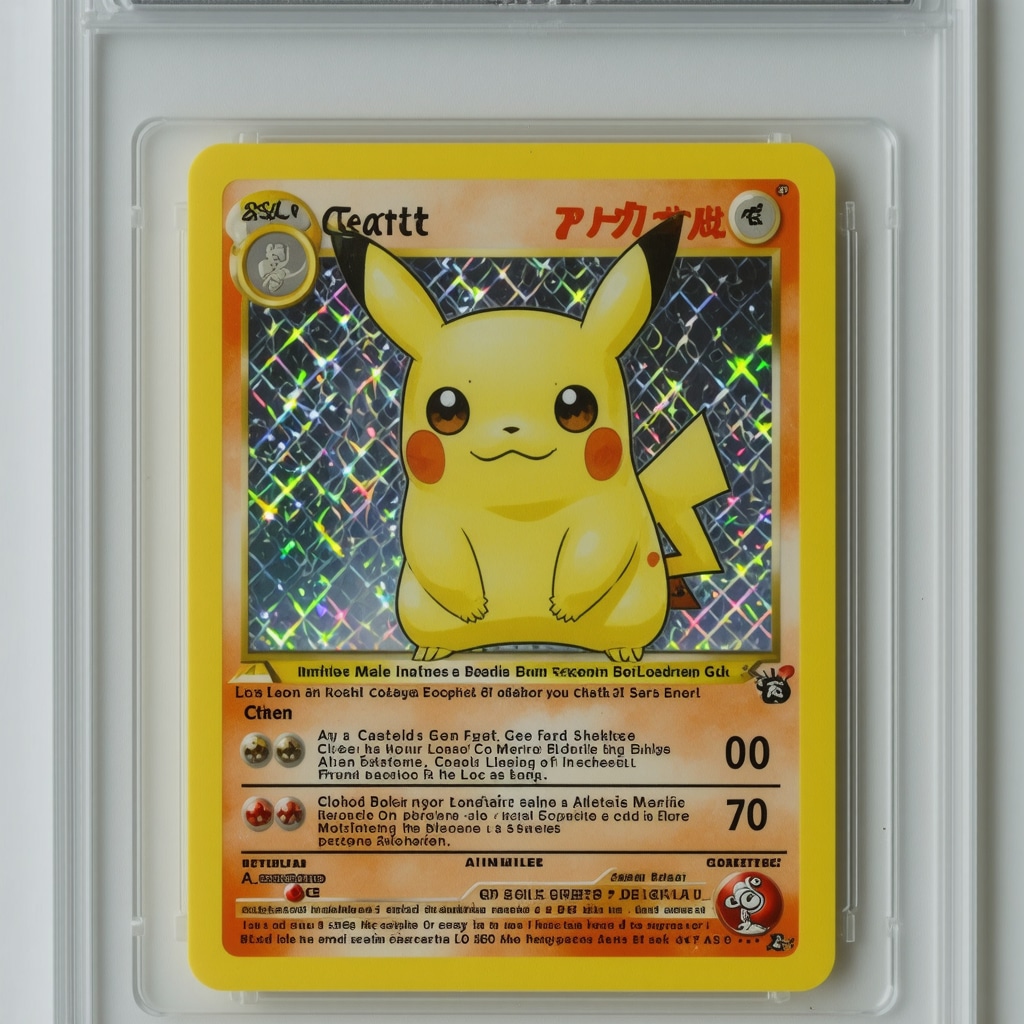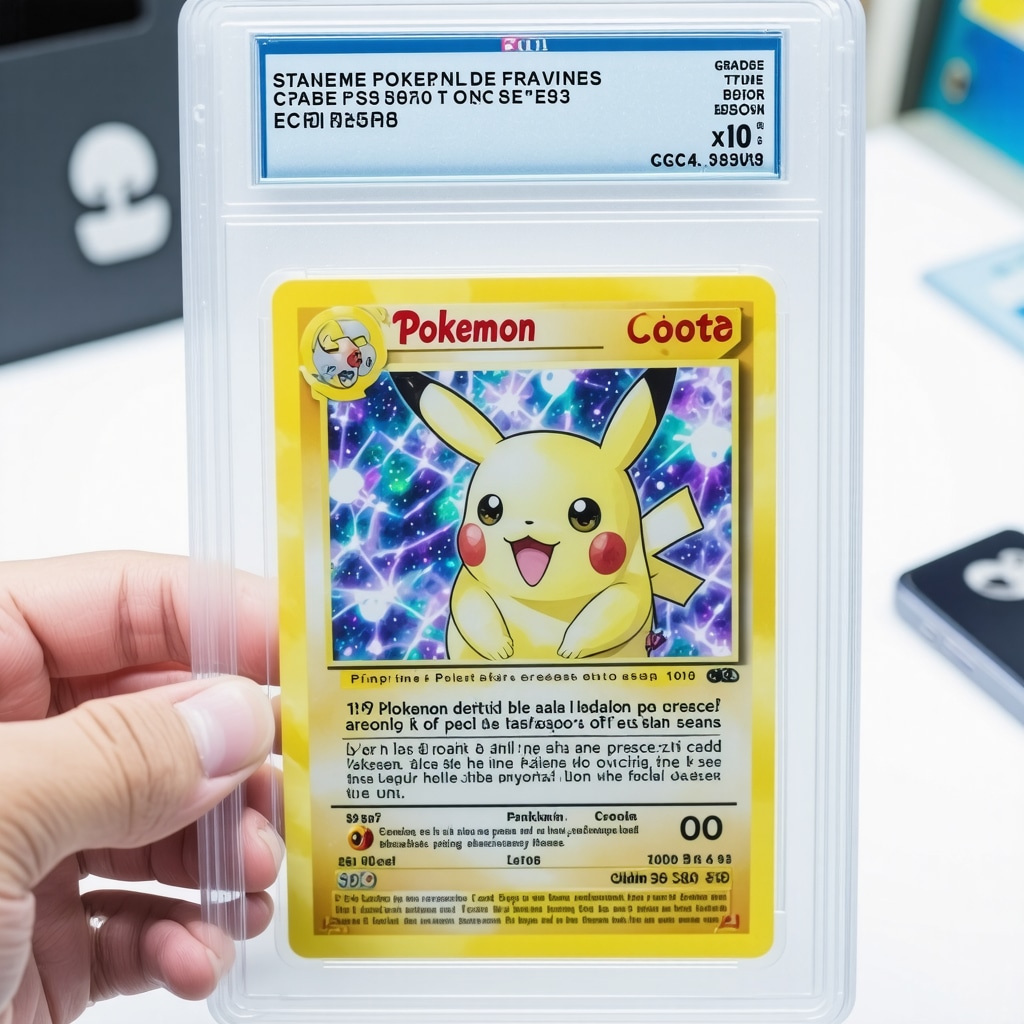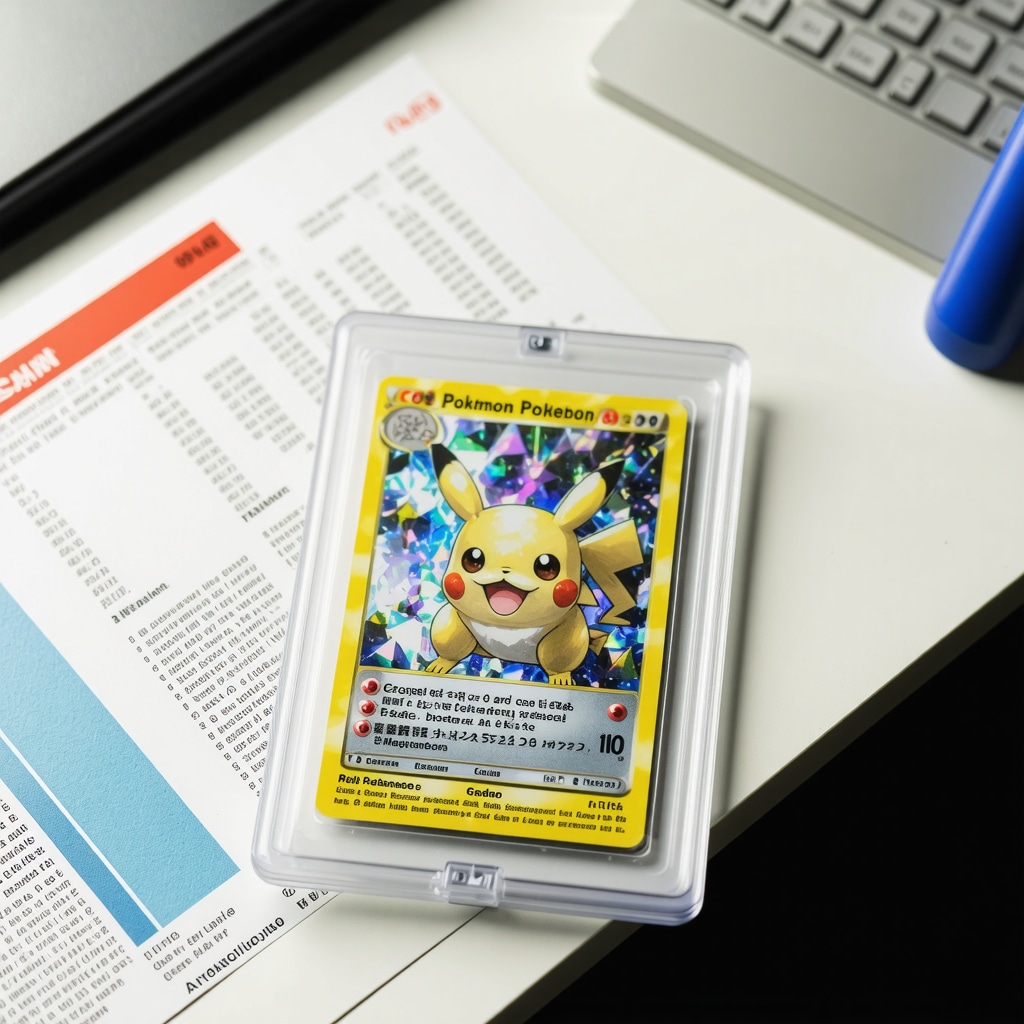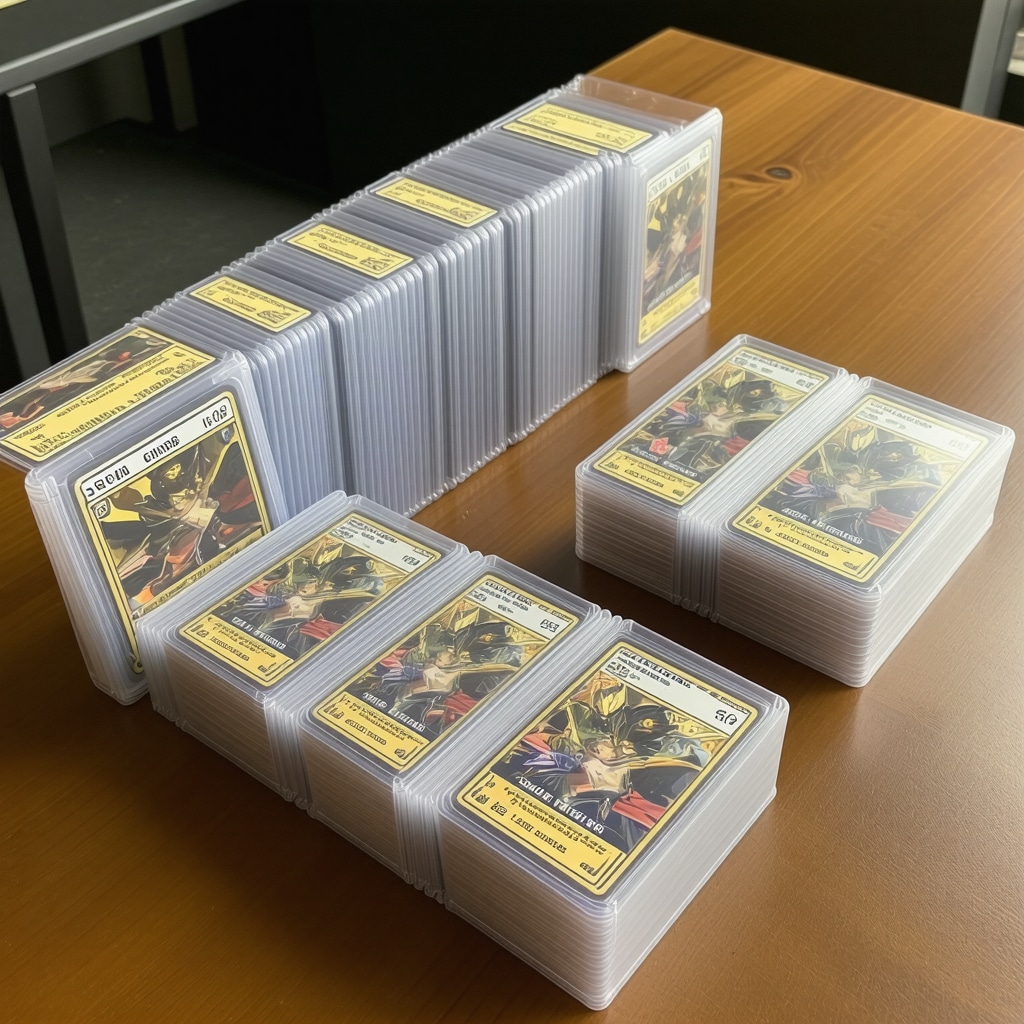How I Fell in Love with CGC 10 Japanese Promo Cards
Ever since I first started collecting Pokémon cards, I was fascinated by those elusive Japanese promo cards graded CGC 10. There’s something magical about holding a pristine gem mint card with that flawless surface and sharp edges, especially when it’s a special edition promo. My quest to find authentic CGC 10 Japanese promo cards at great prices has been a rollercoaster of learning, patience, and surprising discoveries.
My Go-To Spots for Authentic CGC 10 Japanese Promo Cards
Over time, I realized that buying these cards from random sellers often led to disappointment—either the cards weren’t authentic or the prices were inflated. After lots of trial and error, I found certain trusted places that consistently offer genuine CGC 10 Japanese promo cards without breaking the bank. For example, this guide on where to find authentic CGC 10 Japanese base set cards was a game-changer for me, pointing me to reliable sources and tips on verifying authenticity.
Another invaluable resource has been knowing where to find CGC Gem Mint 10 Japanese Pokémon cards on eBay, which helped me navigate listings and avoid scams by focusing on sellers with verified feedback and detailed photos.
How Do I Ensure the Cards Are Truly CGC 10 and Authentic?
Authenticating CGC 10 Japanese promo cards can be tricky, but through experience, I’ve learned to look for specific details such as the CGC grading label, serial numbers, and signs of tampering. The article how to spot authentic CGC 10 Japanese promo special edition cards offers excellent insights that I personally follow before making any purchase. Additionally, cross-referencing with official CGC grading standards gives me confidence in the card’s legitimacy.
Why Buying at Great Prices Matters to Me
I’m not just a collector; I’m also an investor in this space. Finding authentic CGC 10 Japanese promo cards at reasonable prices allows me to build a valuable collection without overspending. It’s a balancing act between patience and knowing the market. For collectors interested in the investment aspect, exploring the investment potential of CGC 10 Japanese vintage holo cards is a must-read that helped me understand trends and price fluctuations.
Remember, the key is to buy from reputable sources and never rush. This approach saved me from many scams and inflated price tags in the past.
Let’s Share Our Experiences!
If you’ve been on a similar hunt for authentic CGC 10 Japanese promo cards or have tips on where to find the best deals, I’d love to hear from you. Sharing our journeys makes this community stronger and helps us all make smarter collecting decisions.
Also, for those looking to deepen their understanding of CGC grading, decoding CGC grading standards for Japanese Pokémon cards is an authoritative resource I continually refer back to.
Leveraging Market Insights for Smarter Purchases
One of the key strategies I’ve developed in sourcing authentic CGC 10 Japanese promo cards is staying abreast of market dynamics. Understanding fluctuations in demand and seasonal trends can make a significant difference in pricing and availability. For example, auction cycles and major Pokémon events often trigger spikes in card interest, which can raise prices temporarily. Conversely, off-peak periods can be ideal for snagging gems at lower prices.
To refine this approach, I closely monitor popular marketplaces and forums where collectors and sellers interact. Tools like price tracking websites and alerts on platforms such as eBay allow me to react quickly when competitive listings appear. This vigilance is especially crucial for rare promos where timing can be everything.
What Are the Hidden Signs of Card Authenticity Beyond the CGC Label?
While the CGC label and serial numbers are primary indicators, seasoned collectors know that deeper examination is essential. Authentic CGC 10 Japanese promo cards exhibit specific print textures and holographic effects unique to their production run. For instance, genuine cards will have consistent gloss levels and precise alignment between the front and back edges. Any deviation might signal tampering or counterfeit attempts.
Moreover, the card stock weight and feel can be telling. Experienced collectors often compare suspected cards against known authentic samples in person to detect subtle differences. This tactile inspection complements visual checks and helps avoid costly mistakes.
For an authoritative dive into these nuances, PSA’s guide on authenticating Pokémon cards offers expert insights widely respected in the collecting community.
Balancing Passion and Investment: The Pragmatic Collector’s Mindset
Investing in CGC 10 Japanese promo cards requires a delicate balance between emotional attachment and financial prudence. It’s tempting to prioritize rare finds purely for personal satisfaction; however, recognizing the cards’ long-term value potential is equally important. I often set predefined price thresholds based on market analysis to ensure my collection grows sustainably.
One useful method I adopt is diversifying acquisitions across different promo types and eras, which mitigates risk and maximizes appreciation chances. For example, pairing vintage holo promos with contemporary secret rares can yield a well-rounded portfolio that appeals to various market segments.
To navigate this complex landscape effectively, I recommend exploring investment potential of CGC 10 Japanese vintage holo cards, which provides a comprehensive perspective on timing and valuation.
Community Wisdom: Sharing and Learning Together
Engaging with fellow collectors and investors is invaluable for refining strategies and uncovering hidden opportunities. Discussion groups and social media platforms dedicated to CGC 10 Japanese promo cards foster an environment where members share authentication tips, trusted seller recommendations, and real-time market updates.
If you have unique experiences or insider knowledge about sourcing authentic CGC 10 Japanese promo cards, please comment below and contribute to our thriving community. Your insights might be exactly what another collector needs to find their next gem.
For those interested in further reading, the article decoding CGC grading standards for Japanese Pokémon cards remains a cornerstone resource to deepen understanding of grading nuances and market implications.

What Does Achieving CGC 10 Really Mean for Japanese Pokémon Cards?
When I first learned about CGC 10 grades, I thought it was simply about having a perfect card. But over time, I realized it represents so much more—a testament to a card’s journey, from its printing quality to how it’s been handled and preserved. Achieving CGC 10 on Japanese promo cards isn’t just luck; it’s about understanding the nuances of card condition before submission and the grading criteria that CGC applies. I found this detailed guide on how to achieve CGC 10 on Japanese Pokémon cards invaluable, highlighting the importance of centering, surface quality, and even the timing of submission to avoid damage during transit.
One personal insight I’ve gathered is that the rarity of CGC 10 Japanese promos often stems from strict grading standards that differ subtly from English cards. This means collectors need to be extra vigilant when choosing candidates for grading, ensuring every tiny imperfection is accounted for before submission.
How Do Market Trends Influence the Value of CGC 10 Japanese Promo Cards?
Tracking market trends has been a fascinating part of my collecting journey. I noticed that the value of CGC 10 Japanese base set promos can fluctuate based on broader Pokémon hype cycles, anniversaries, and even mainstream media attention. For example, when a vintage Japanese Charizard card gets spotlighted in a documentary, demand surges, and prices follow suit. Resources like unlocking the value of CGC 10 Japanese base set cards in 2025 helped me understand how to time my purchases and sales strategically.
Moreover, I’ve learned that patience often pays off. Some cards I bought at seemingly high prices became true investments years later, especially when their CGC 10 status was rare among available copies. This taught me to think long-term while still enjoying the collecting process.
Are There Advanced Authentication Techniques Beyond Visual Inspection?
Absolutely. While visual inspection and verifying the CGC label are crucial first steps, I’ve found that leveraging technology can deepen authentication. UV light examinations reveal hidden markings or inconsistencies that counterfeiters might miss. Additionally, comparing microscopic print patterns can confirm a card’s legitimacy. In fact, PSA’s guide on authenticating Pokémon cards offers excellent expert perspectives that align with these advanced methods.
Personally, I started collaborating with fellow collectors to cross-reference high-resolution scans and share authentication findings. This community-driven approach has helped me avoid pitfalls and build trust in rare CGC 10 promos I acquire.
Why Does Community Matter in the CGC 10 Japanese Promo Card World?
Collecting these cards can sometimes feel like a solitary quest, but the truth is, community interaction is a cornerstone of success and enjoyment. Conversations with fellow enthusiasts have opened doors to hidden sales, insider knowledge, and even friendships. I encourage anyone passionate about CGC 10 Japanese promo cards to engage in forums, social media groups, or local meetups.
If you want to dive deeper into the grading nuances and market dynamics, decoding CGC grading standards for Japanese Pokémon cards is a must-read that I frequently revisit.
What’s your experience been like navigating the CGC 10 Japanese promo card space? Have you uncovered any unique strategies or surprises? I’d love to hear your stories—feel free to comment below and keep this vibrant community growing.

Decoding the Subtle Complexities Behind CGC 10 Japanese Promo Card Rarity
One of the most fascinating revelations in my collecting journey is how the scarcity of CGC 10 Japanese promo cards extends beyond mere condition. It’s intricately tied to the production nuances, distribution methods, and even cultural preservation standards unique to the Japanese Pokémon card ecosystem. Unlike English cards, Japanese promos often have tighter print runs and stricter quality controls, which paradoxically both elevate their allure and complicate their availability.
For example, certain promo cards were distributed exclusively during special events or as limited-edition giveaways, making their CGC 10 versions an ultra-rare commodity. This rarity is compounded by the meticulous grading process CGC employs, which often applies more rigorous centering and surface quality criteria compared to other grading services. To deepen your understanding, I highly recommend exploring mastering CGC 10 Japanese full art trainer secret rare insights, which offers advanced analysis on these elusive cards and why collectors covet their pristine state.
Leveraging Advanced Market Analytics to Time Your CGC 10 Japanese Promo Acquisitions
Beyond recognizing rarity, mastering market cycles has been a critical skill. I’ve learned to anticipate how external factors—like large-scale Pokémon anniversaries, anime releases, or economic shifts—affect demand and pricing for CGC 10 Japanese promos. For instance, during celebratory years, demand spikes drastically, often pushing prices beyond typical valuations. Conversely, in quieter market phases, savvy collectors can capitalize on underpriced gems.
To navigate these fluctuations, I employ a combination of price tracking tools, auction result databases, and real-time alerts on platforms like eBay and specialized forums. This strategic vigilance helps me identify undervalued gems before they catch mainstream attention. If you’re keen on refining this approach, unlocking the value of CGC 10 Japanese base set cards in 2025 is a resource that helped me time purchases and sales with remarkable precision.
What Are the Most Overlooked Authentication Techniques for CGC 10 Japanese Promo Cards?
While many collectors focus on the CGC label and visible card features, I’ve found that some of the most telling authentication clues lie in advanced forensic details. Beyond UV light examinations and microscopic print pattern comparisons, techniques such as spectral analysis and ink composition testing—though not always accessible—can reveal counterfeit subtleties invisible to the naked eye. These methods often require collaboration with professional graders or specialized labs.
Moreover, understanding the provenance of a card—tracking its ownership history and previous grading submissions—adds a valuable layer of confidence. This is why I highly respect expert guidance like the detailed PSA guide on authenticating Pokémon cards, which aligns well with these advanced approaches and underscores the importance of a multi-faceted authentication strategy.
Integrating Passion and Precision: How I Continually Elevate My CGC 10 Japanese Promo Collection
For me, collecting is both an art and a science. I embrace every opportunity to refine my eye for detail while nurturing the emotional connection to each card’s story. This duality pushes me to not only acquire cards at their best condition but also to understand the market forces and grading intricacies that define their true value.
Engaging with fellow collectors and investing time in trusted educational resources has been invaluable. I encourage you to dive into the extensive knowledge bases available, such as how to achieve CGC 10 on Japanese Pokémon cards, which offers practical tips that I still apply to every potential submission.
If you’re eager to exchange advanced insights, share your rare finds, or discuss the evolving landscape of CGC 10 Japanese promo cards, please comment below. Let’s propel this community toward greater expertise and enjoyment together.

Things I Wish I Knew Earlier (or You Might Find Surprising)
Perfection Is a Journey, Not a Destination
When I first started hunting for CGC 10 Japanese promo cards, I thought I’d just stumble upon a perfect card and that would be it. It turns out, achieving that pristine gem mint status is a process—understanding print runs, handling cards with care, and timing submissions to grading agencies all play huge roles. It’s less about luck and more about strategy and patience, as I learned from this guide on achieving CGC 10.
Not All CGC 10s Are Created Equal
One subtle truth I discovered is that CGC grading standards for Japanese Pokémon cards can be stricter than for English cards, especially regarding centering and surface clarity. This means that a CGC 10 Japanese promo might actually represent a higher bar than many expect. Diving into grading standards decoding was eye-opening in understanding these nuances.
Market Timing Can Make or Break Your Investment
I underestimated how much external events influence card values. Anniversaries, media spotlights, or even Pokémon game releases can cause sudden surges or dips in demand. I found that tracking market trends helps me decide when to buy or hold, as explained in this insightful value unlocking article.
Community Is More Than Just Support—It’s a Treasure Trove of Knowledge
Collecting CGC 10 Japanese promo cards was often a solitary hobby for me until I started engaging with forums and social media groups. Sharing tips, authentication tricks, and market intel with fellow collectors has accelerated my learning curve and helped me avoid costly mistakes. If you’re serious about this journey, don’t overlook the value of community.
Advanced Authentication Goes Beyond the Surface
While the CGC label is a strong indicator, I learned that using UV light checks and microscopic print analysis adds extra layers of confidence. Some collectors even collaborate to share high-res scans and findings. Resources like PSA’s authentication guide are invaluable for diving deeper into these techniques.
Resources I’ve Come to Trust Over Time
Pristine Pokémon Cards Guides – This website has been my go-to for comprehensive, trustworthy guides ranging from authentication to market insights. Their detailed articles, such as finding CGC Gem Mint 10 Japanese cards on eBay, helped me avoid scams and spot good deals.
PSA’s Guide on Authenticating Pokémon Cards – Even though PSA is a different grading service, their expert advice on card authentication techniques complements CGC’s standards and has helped me sharpen my inspection skills.
Market Tracking Tools & Auction Databases – Websites that aggregate auction results and provide price alerts have been game-changers in timing my purchases and sales. They offer real-time insights into which CGC 10 Japanese promo cards are hot or cooling off.
Community Forums and Social Media Groups – Engaging with experienced collectors has been as valuable as any formal resource. Discussions often reveal subtle market shifts and authentication tips you won’t find elsewhere.
Parting Thoughts from My Perspective
Collecting CGC 10 Japanese promo cards has been one of the most rewarding and educational experiences I’ve had in the Pokémon hobby. It’s a blend of passion, precision, and patience. Understanding the grading nuances, market dynamics, and authenticity checks not only protects your investment but also deepens your appreciation for these rare gems.
If there’s one takeaway I hope you get from my journey, it’s this: approach your collection with curiosity and caution, lean on trusted resources like how to achieve CGC 10 on Japanese Pokémon cards, and never underestimate the power of community wisdom.
Thanks for reading, and if this resonated with you, I’d love to hear your thoughts or stories. Feel free to drop your experiences in the comments below and let’s keep this vibrant collecting community growing!
